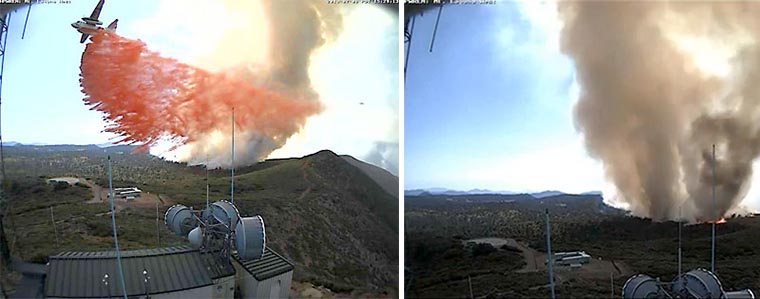This is a reprint of a San Diego Supercomputer Center news release
UC San Diego’s HPWREN Aids Firefighters in Chariot Fire
High-Performance Camera Network Provides Public Safety Net
07/10/2013
The high-speed data transmission network of the UC San Diego-based High-Performance Wireless and Research Education Network (HPWREN) is once again showing its utility as a public safety asset as firefighters battle the 7,000-acre Chariot Fire near Mount Laguna, east of San Diego.
The fast-moving blaze that burned through 120 structures in the Mount Laguna area and scorched 7,055 acres slowed greatly as of Wednesday morning, with firefighters taking advantage of calmer winds to gain more control of the wildfire. By Tuesday night, about 2,100 firefighters had the blaze 40 percent contained. The fire broke out around 1 p.m. Saturday at Chariot Canyon Road and Oriflamme Canyon Road, almost 10 miles southeast of Julian.
Since the wildfire began, more than 10,000 people have accessed HPWREN’s camera images and data as the fire spread. Many of those images have been used by the news media and viewed by the general public and first responders. A compressed video showing once-per-second images of the fire taken via a stationary HPWREN camera can be found on YouTube. Real-time images are available on the HPWREN cameras webpage.

Images of the July 2013 Chariot Fire on Mt. Laguna via a stationary HPWREN camera provided by SDG&E. Courtesy of HPWREN/SDSC.
“HPWREN’s fire station connections, environmental cameras, meteorological and other sensors were used early on to assist firefighters and other emergency personnel,” said Hans-Werner Braun, HPWREN’s director and a research scientist with the San Diego Supercomputer Center (SDSC), an Organized Research Unit of UC San Diego.
HPWREN has continued to evolve since it was originally formed as UC San Diego research project and funded by the National Science Foundation (NSF) about 13 years ago. Braun credits the continued growth of HPWREN to a new partnership with San Diego Gas & Electric (SDG&E).
The utility has assisted in connecting nearly 70 remote fire stations to the HPWREN network via the Area Situational Awareness for Public Safety Network (ASAPnet) extension – a collaborative effort to provide broadband and Internet connectivity to 70 fire stations in the most remote parts of the county. The broadband connectivity provided by the ASAPnet program is now being used to support the CalFire Incident Post at Puerta La Cruz as they work to fight the Chariot Fire.
“This partnership, which includes several other academic and government organizations, has allowed for the provisioning of many more environment-observing cameras with capabilities beyond the previously used cameras (such as near-infrared sensing), as well as several more weather stations that can provide firefighters with up-to-the-second real-time wind data,” said Braun. “Taken together, this has substantially enhanced the capabilities of HPWREN and our ability to effectively and immediately serve the public at large, especially in such rapidly changing and dangerous situations as this latest fire.”
“SDG&E is proud to be part of a collaborative effort that benefits the entire community – specifically, fire agencies and first responders,” said Michael R. Niggli, president and chief operating officer for SDG&E. “The investments we are making in technology, like HPWREN, are geared primarily to improving SDG&E’s overall situational awareness, and it is deeply satisfying to know the benefits are multiplied across our entire service area.”
“Our collaboration with SDG&E is just one example of SDSC¹s efforts to partner with industry leaders in a variety of areas to create programs that benefit society on many levels,” added SDSC Director Michael Norman. “These partnerships can pay long-term dividends to both local communities, as well as communities around that world that can use the latest infrastructures and advanced technologies to help solve everyday challenges.”
In addition to SDG&E and UC San Diego, the partnership includes San Diego State University, as well as the local, state, and federal agencies including County of San Diego’s Fire Authority and Sheriff's Department, the State of California’s Department of Forestry and Fire Protection (CAL FIRE), and the United States Forest Service.
About HPWREN
The High-Performance Wireless Research and Education Network (HPWREN) is one of the Applied Network Research (ANR) projects at the University of California, San Diego. HPWREN functions as a collaborative Internet-connected cyberinfrastructure on research, education, and public safety activities. The project supports a wireless data network in San Diego, Riverside, and Imperial counties. The network includes backbone nodes, typically on mountain tops, to connect often hard-to-reach areas in remote environments.
About ASAPnet
The Area Situational Awareness for Public Safety Network (ASAPnet) is a partnership-based extension of UC San Diego’s HPWREN infrastructure project for the benefit of public safety communities, especially firefighters in San Diego County in their function as first responders. This activity seeks to build out high performance data networking to firefighter assets, while also utilizing environment-observing cameras and other sensors.
Media Contacts:
Jan Zverina, SDSC Communications
858 534-5111 or jzverina@sdsc.edu
Amber Albrecht, SDG&E Media Relations
858 654-1796 or aalbrecht@semprautilities.com
Warren R. Froelich, SDSC Communications
858 822-3622 or froelich@sdsc.edu
